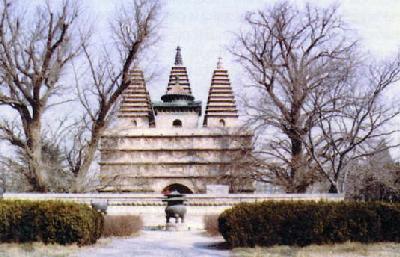The Diamond Pagoda is of a group pagoda combination method, composed of a large pagoda at the center and a small pagoda on each side of the four corners. The various pagodas are either of a bottle type or of a Han type. According to Tibetan Buddhism, the Diamond Pagoda symbolizes the five Buddhas of vajradhatu (diamond element). It is also the expression of the Mandala concept about the universe. In fact, this form had already emerged during the Northern and Southern dynasties (420-581). Nirvana symbolizing Buddha was already drawn in the murals of the Northern Dynasty (386-581) in the Dunhuang Grottoes, its shape and structure originating from
India's Buddhaghosa Pagoda.
Extant important diamond pagodas includeBeijing's Stupa of the Five-Division Vajnadhatu (Zhenjue Monastery, built in 1473), Biyun Monastery, Qing Jinghua Chengta of Xi Huang Si, and the Cideng Monastery inHohhot. In front of the Miaozhan Monastery of Kunming Guandu, there is one such monastery, called Miaoying Lanruo Pagoda.
Existing well-known cross-street pagodas include the Yuntai in northwestBeijing'sJuyongguanPassand the Yuntai Shanta in Zhenjiang of Jiangsu Province, both built during the Yuan Dynasty.
